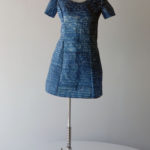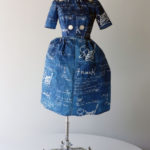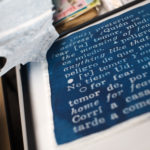Paper Dresses Annie Lopez

Writer Donna Kublin
Photography Loralei Lazurek
[dropcap]O[/dropcap]ver the past several decades, nationally exhibited artist Annie Lopez has consistently created new bodies of work exploring a variety of subjects. Through it, she presents a dialogue about race, stereotypes, the local art world, relationships and family, all done with a combination of frankness and humor.
A fourth-generation Phoenix resident, Lopez was recently honored with the 2016 Governor’s Arts Award for individual artist. Her work has been exhibited at museums across the country, including “Paper!” at the Phoenix Art Museum; “American Voices” at the Smithsonian Institution; “The Show” at the Museum of Fine Arts in Santa Fe; “In Celebration: A Century of Arizona Women Artists,” which traveled throughout Arizona; and, most recently, “Cyanotypes: Photography’s Blue Period” at the Worcester Art Museum in Worcester, Massachusetts. Two of her pieces are currently on exhibit at the National Hispanic Cultural Center in Albuquerque, New Mexico. She has been given solo exhibits at the Phoenix Art Museum, University of Arizona, Arizona State University and MARS Artspace.
Part of the Phoenix art scene since 1982, Lopez at first struggled to gain recognition for her fine art photography. Establishment decision-makers referred to her work as “too Chicano,” deciding that entirely based on her name, while Hispanic decision-makers told her it was “not Chicano enough.” Neither group saw her as who she was and what she is today: an amazing visual storyteller that defies any category.
Instead of taking their comments as obstacles, though, Lopez began poking fun at them in her work. In her “Hispanic” series, which she started in the mid-1980s and continues today, she selected images and comments from all the differing voices: those telling her that she wasn’t Mexican enough, such as her mother saying “You’ll never get a man to marry you if you don’t learn to make tortillas;” Latina magazines telling her how to look and dress; and negative comments based upon assumptions about her heritage, her skin color and her name.
For Lopez, art is very personal. Creating art from her experience, she crafts visual stories that are unique and tells them with a powerful combination of straight-forwardness and humor, which makes her personal experience universal — something relatable to everyone.
She does this by using family photographs, vintage found photos, personal letters and short stories. The images and the statements she makes through her art continue to evolve from her early photographic work.
As Lopez grew as an artist and storyteller, she sought other means and materials that would push her work beyond traditional bounds. In a workshop she attended in the late 1980s, she was introduced to cyanotype processes and how it could be used in her photography.
Invented by Sir John Herschel in 1842, cyanotypes are photographs with a distinctive Prussian blue tonality produced by treating paper with an iron-salt solution. The treated paper can be developed using only the sun, which made cyanotypes a favored technique among amateur photographers through the turn of the 20th century. Contemporary artists have recently revived the process, manipulating the medium to varied expressive effects.
Lopez loved it. She felt she could capture more of what she intended with this medium rather than just black and white film.
Her cyanotype series titled, “Almost Real History of Art in Phoenix” was purchased by the Phoenix Art Museum. As a truth teller, some of the text does not reflect well on past decisions of the museum, such as asking local artists to contribute art for fundraisers so the museum could buy art from people living elsewhere. Nevertheless, it is part of their permanent collection.
In 2012, Lopez received the Contemporary Forum Mid-Career Artist Award, which recognizes sustained excellence and commitment, and she was asked to create a series of works to display at the Phoenix Art Museum.
It seemed a somewhat daunting task for her since the exhibit space was the very large lobby with few walls and called for 3-D, sculptural forms, rather than her framed artwork. She didn’t know what she was going to do.
At the same time in her life, she was emotionally absorbed with helping her father in his battle with Alzheimer’s disease. It was difficult for her, but it inspired the creation of a work titled, “Remnants of Long Term Memory” about her father’s Alzheimer’s, which is covered in his handwriting. The project also inspired new medium used in a unique way.
“I’m always exploring what to print on,” said Lopez, who had begun to print her cyanotypes on paper used to wrap tamales. “My family made tamales every Christmas, so that came to mind as a possibility.” Having success with it, she thought there had to be another purpose that she could use them for.
“I wanted to sew my troubles into a dress,” she said, “but that required the right material, and the qualities of the tamale paper were perfect for the application.”
Combining her skills at photography, storytelling, cyanotypes, sewing (she has made her own clothes since she was 8 years old), Lopez made her first dresses using tamale paper. The created dresses transformed photographs into sculptural forms and were perfect for the lobby space.
The show featured 14 paper dresses created from old patterns, with each dress connecting to moments in her life. For example, one dress titled, “C Student,” is about receiving a C on her first grade report card in art, and includes images of her actual report card. “Fire Took What Was Left of Us” is about an arson fire that destroyed her family’s business a year after her father died. The dress is covered in fire reports from the investigation (or lack thereof, according to Lopez) by the Phoenix Fire Department.
The pieced together images on tamale paper form the fabric from which the dress pattern is cut. Once imagined, each image takes about 20 minutes to print and each dress takes 20 to 40 sheets of tamale paper. As she designs the dress, the prints are crafted, arranged, added to and recreated as needed to tell her story.
Lopez continues creating dresses using her personal stories, and she honors her family in her “Storybook” series.
“Another story, another dress,” she said.
“The artwork I am drawn to are ones in which the artist includes something personal, something I can connect with.” Her advice for up-and-coming artists: “I encourage everybody to speak their minds, because it’s healthy, and it helps put more meaning into their artwork if they’re saying what they’re doing rather than oh, this is a pretty picture. It adds more weight to their work.”
For 17 years, Lopez was an artist member with the nationally recognized Chicano arts organization MARS (Movimiento Artistico del Rio Salado), which had a big influence on her work and the recognition of Hispanic art in Phoenix. Through their efforts, art by Latino artists has become an important part of the culture of the Valley. It was at MARS that she met her husband of 30 years, artist Jeff Falk, the first non-Hispanic man to join the group.
Daniel Buckley, director, author and 2014 Governor’s Arts Awards honoree, says in a video statement about Lopez: “Annie tells deeply moving, important stories with humor that humanizes the entire experience and makes it relatable to anyone. That is what makes her art so powerful. That’s a gift.”







